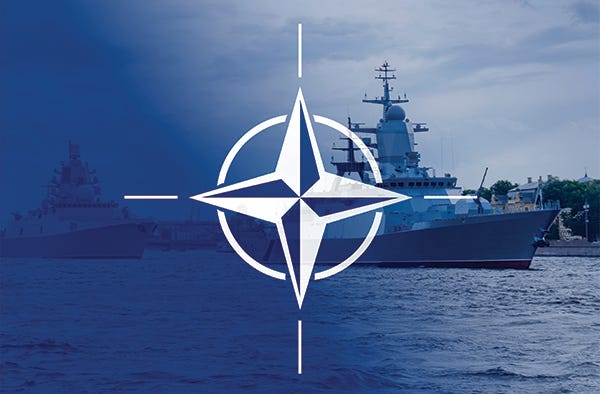NATO's Cognitive Warfare Concept Is Actually Ancient
Old Tactics, New Technology: Recognizing Cognitive Warfare's Ancient Playbook
In March 2022, as Russian tanks rolled into Ukraine, another invasion had already achieved its intent.
It wasn’t land based.
It was social.
Social media feeds across Europe flooded with claims that Ukrainian soldiers were committing atrocities. Online forums exploded with theories that Western powers had provoked Russia. Public figures amplified messages questioning why citizens should suffer economic hardship for a far-away conflict.
Let’s be clear, those are attacks. Like traditional weapons, they aim at specific targets with measurable objectives: weaken collective resolve, create division among allies, and ultimately shape policy decisions without firing a single bullet.
NATO calls this "cognitive warfare." It is define it as activities that affect attitudes and behaviours by influencing, protecting, or disrupting how individuals and groups process information. Military strategists now rank these operations alongside land, sea, air, space, and cyber as critical domains of modern conflict.
But NATO's newly labelled "cognitive warfare" is actually one of humanity's oldest battlefield in modern dress. The tactics of mind manipulation have existed since ancient times, only the technology and terminology have changed.
The Enduring Nature Cognitive Warfare
Military theorists distinguish between war's enduring nature and its changing character. This lens reveals something profound about cognitive warfare.
The nature of cognitive warfare remains constant across millennia. It exploits fundamental limitations in human cognition that evolution hasn't eliminated. Our brains still use the same shortcuts and suffer the same blind spots as our ancestors.
Fear short-circuits rational thinking. When Roman generals staged elaborate religious rituals before battle, they tapped the same primal response as modern disinformation campaigns about foreign threats. Both exploit the fear every human experiences, making it a really impactful tactic.
Trust is meant to serve as our mental gatekeeper. Persian kings used royal seals knowing we accept information more readily from authorities we recognize. Today's deepfakes exploit this same tendency by mimicking trusted voices and faces.
This principle of authority exploitation has ancient roots. Medieval rulers employed uniformed heralds because official messengers commanded trust. These days labels, blue check marks, and follower size have replaced this. The attack vector remains unchanged as it exploits our tendency to trust information when it appears to come from trusted sources.
Group identity filters what we believe. The ancient Chinese text "The Art of War" advised turning enemy factions against each other because humans more readily accept information that reinforces existing tribal loyalties. When the Romans spread rumors that Carthaginians sacrificed children, they knew citizens would believe these atrocities about an outgroup that was foreign and threatening. Modern disinformation campaigns exploit this same tendency when they plant stories that confirm existing prejudices about political opponents.
The psychological mechanism remains identical: information that aligns with our group identity bypasses our critical thinking.
We scrutinize challenging claims from outgroups while accepting supportive claims from our ingroup with minimal verification. This filtering system evolved for tribal survival but creates predictable blind spots that manipulators have targeted for millennia.
The Evolving Character Of Cognitive Warfare
What has transformed is cognitive warfare's delivery system. Today's methods differ from ancient ones in four critical dimensions:
Precision has evolved from blunt propaganda to algorithmic targeting that identifies and exploits individual psychological profiles. Ancient rulers broadcast identical messages to entire populations. Roman proclamations reached everyone in the public square regardless of their susceptibilities.
However, today's campaigns segment audiences with incredible specificity. Messages are tailored to personality types, beliefs, and specific vulnerabilities. Operators can and have conducted A/B testing across large data sets, measuring which exact wording or imagery to produces the strongest response.
Speed has compressed from months to microseconds, eliminating the natural buffer time that once allowed reflection before information spread. News of Persian King Darius's defeat at Marathon took days to reach Athens. Information about the fall of Constantinople took weeks to reach Western Europe. This delay created natural space for verification and contemplation. However, today, messages circle the globe in seconds, reaching billions of people through smartphones and constant internet connectivity.
Nearly 5 billion people now carry internet-connected devices that push notifications instantly. That is over 60% of humanity. False information can trigger real-world consequences before anyone has time to determine its accuracy. The cognitive processes humans developed for evaluating information never evolved to handle this speed and volume. Our brains still process information at the same rate as our ancestors, but the buffer that once protected us from impulse reactions has vanished in the digital age.
Scale has expanded beyond geographic constraints, allowing coordinated campaigns to simultaneously affect millions across cultural and national boundaries. Ancient empires struggled to maintain consistent messaging even within their territories. Roman propaganda spread slowly through physical artefacts and messengers. The most successful historical campaigns might reach thousands of people.
Today, a single social media post can reach millions within hours. Coordinated messaging can blanket entire continents simultaneously, crossing language barriers and cultural divides. The 2016 Russian influence operations reached an estimated 126 million Americans on just one platform.
Cognitive warfare also transcends traditional geographic constraints. The reach of influence operations has expanded from local to global. A single team operating from a Moscow basement can now target vulnerable populations across Africa without ever setting foot outside of their basement.
In ancient times, Viking raiders could only spread terror through stories of their brutality to nearby coastal communities. The Mongol empire required decades to build its fearsome reputation across Asia. But, today, small groups with minimal resources can project cognitive influence far beyond their physical reach.
This represents a fundamental shift in power projection. Nations no longer need massive military forces to affect populations thousands of miles away. The barriers of distance, language, and cultural knowledge have been dramatically reduced by digital connectivity and translation technologies.
Long Before NATO
Long before NATO coined the term "cognitive warfare," civilizations mastered the art of manipulating perception to achieve strategic goals. Their methods targeted the same cognitive vulnerabilities that NATO now identifies as attack vectors.
The Persian Empire excelled at what NATO would call "attacking and degrading rationality." King Darius I created the Royal Road, a network of messengers that carried carefully crafted narratives about Persian power. When Xerxes needed to motivate his invasion force against Greece, he employed religious ceremonies and prophecies to convince his troops of divine favour. These tactics deliberately bypassed rational thought processes, targeting emotional and subconscious domains. This is similar to what NATO identifies as a vulnerability in modern cognitive warfare.
Byzantine diplomacy pioneered what NATO describes as "whole-of-society manipulation." The Eastern Roman Empire survived for nearly a thousand years despite being surrounded by powerful enemies. Their defence was largely through psychological operations. Byzantine emperors maintained elaborate court ceremonies designed to awe foreign ambassadors. Visitors encountered mechanical lions that roared and automated thrones that rose into the air. These displays created an overwhelming impression of Byzantine power, manipulating perceptions of reality. This is another key attack vector in NATO's cognitive warfare framework.
The Byzantines also mastered "exploiting vulnerabilities" and creating divisions. Emperor Constantine VII wrote "De Administrando Imperio" that explicitly instructed his successors on how to manipulate the perceptions of neighboring peoples and turn allies against each other. This text outlines strategies for creating what NATO now calls "us vs them polarization"—tactics to divide opponents and weaken their collective resolve.
Genghis Khan perfected what NATO identifies as "decaying public trust." The Mongols would sometimes spare messengers from conquered cities specifically to spread stories of their ruthlessness. This psychological tactic often led to cities surrendering without resistance. By controlling the narrative about Mongol conquest, they created an environment of fear where populations couldn't trust their own leaders' ability to protect them.
Even "lawfare", which is using legal systems and social norms as weapons, has ancient roots. Roman propaganda often portrayed enemies as violators of natural law or sacred boundaries to justify military action. This manipulation of legal and moral frameworks legitimized aggression while undermining opposition.
What makes these historical examples significant is how perfectly they align with NATO's modern concerns about cognitive warfare. These weren't primitive precursors to today's operations. They were cognitive warfare. Executed with the tools available at the time, targeting the exact same human vulnerabilities that NATO now works to protect.
Weaponization of Language and Symbolism
Language may be humanity's first cognitive warfare tool. Roman generals renamed conquered cities and landmarks, disrupting cultural continuity and reshaping how populations perceived their own identity.
This parallels the modern debate over calling a conflict an "invasion" or a "special operation". These are no more than labels that determine emotional responses and policy decisions.
Religious and political systems throughout history created specialized vocabularies that frame perception. The ancient Egyptians developed language around the pharaoh's divinity that made questioning his authority nearly unthinkable. NATO observers have noted how today's adversaries similarly create "fundamentally opposed perceptions of reality" through careful language choices that limit what people can easily express or comprehend.
What connects these historical practices to modern cognitive warfare is their exploitation of how human brains process information. The vulnerability to linguistic and symbolic manipulation hasn't evolved significantly.
Only the distribution methods has changed.
The Disturbing Symmetry
Throughout history, cognitive warfare has remained consistent in its targets while evolving dramatically in its delivery methods. What NATO now formally recognizes has been with us since humans first realized that controlling minds often proves more efficient than controlling bodies.
But there's a disturbing insight hidden within this historical perspective.
The most dangerous cognitive operations succeed because targets don't perceive them as warfare at all. Ancient societies generally knew when they were under cognitive attack. Today's most successful campaigns operate in the shadows of normal information consumption. Few citizens scrolling through social media consider they might be targets of calculated psychological operations.
Perhaps most unsettling is that cognitive warfare has always been most successful when it aligns with what people already want to believe. Persian kings amplified existing religious beliefs. Today's most effective campaigns similarly exploit our pre-existing biases, fears, and desires.
NATO's recognition of cognitive warfare is valuable but incomplete without this historical understanding. The battlefield isn't new—it's as old as human communication. Our brains still run on the same operating system that ancient influence experts exploited millennia ago.
The most powerful defence begins with recognition.









